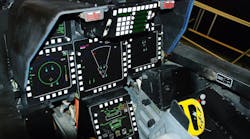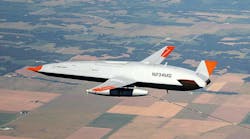Thales partners with Green Hills Software
Thales in Raleigh, N.C., and Green Hills Software in Santa Barbara, Calif., have joined hands to integrate Green Hills Software’s INTEGRITY real-time operating system (RTOS) and MULTI development tools with the Thales single-board computers. The INTEGRITY operating system and board support package are available immediately on Thales Computers products, starting with the Power Engine 7 family, which includes the low-power, 1 GHz PowerPC 750GX. Under the terms of the partnership agreement, Thales has integrated the Green Hills Software INTEGRITY RTOS and MULTI tools into the Thales family of advanced technology PowerPC and Intel-based single board computers, modules, and integrated systems. This includes INTEGRITY board support package development and verification assistance, product training, and joint marketing. For more information visit www.thalescomputers.com and www.ghs.com.
U.S. Army helicopter controls UAV via TCDL wireless links
For the first time in U.S. Army history, an Army helicopter took control of an unmanned aerial vehicle (UAV) using a tactical common data link (TCDL). A TCDL developed by the L-3 Communications Communication Systems-West (CS-West) division helped Army personnel aboard an AH-64 Apache Longbow helicopter remotely command and control a Hunter UAV. The demonstration, part of the Hunter Standoff Killer Team Advanced Concept Technology Development, reached Level IV control of the UAV. Those manning the Apache helicopter used video from the Hunter from farther away than 40 miles. For more information, visit www.l-3com.com.
Updated Paveway II laser-guided bombs hit the target
The U.S. Navy, together with Lockheed Martin Corp., tested an F/A-18 aircraft releasing four GBU-12 Paveway II dual-mode laser-guided bombs (DMLGBs). The U.S. Navy contracted Lockheed Martin in November 2005 to develop and produce Paveway II DMLGB kits, a next-generation precision-guided weapon system. The $65 million contract is to upgrade the Navy’s computer-controlled Paveway II guidance systems with inertial navigation system/global positioning systems. The COTS-based DMLGB kits from the Lockheed Martin Missiles and Fire Control in Archbald, Pa., are designed to strike targets with precision in any weather and at extended ranges. The Naval Air Warfare Center at China Lake Naval Weapons Center, Calif., set the stage for a series of flight tests that involved complex maneuvering, GPS/INS guidance, and urban environment operations. Pilot-coordinated maneuvers tested the weapon’s capabilities in a variety of tactical scenarios, whereas GPS/INS guided flight was demonstrated through the use of preprogrammed target coordinates and the aircraft’s existing targeting pod. While several DMLGB weapons were released on a target, the system simultaneously employed laser designation to track a second target. The pilot also retargeted the weapon by reprogramming its coordinates, as well as employed critical turning maneuvers in an urban environment operations test of the DMLGB’s GPS-aided INS guidance. For more information, visit www.lmco.com.
Northrop Grumman uses Fire Scout UAV to enhance net-centric capabilities
Northrop Grumman Corp. in conjunction with the Office of Naval Research demonstrated extended communications ranges and capabilities using the RQ-8A Fire Scout vertical take-off and landing tactical unmanned aerial vehicle (VTUAV) earlier this year. Testing for the program, called Beyond Line-of-Sight Tactical UAV Communications Relay (BTCR), demonstrated that a tactical UAV can enable over-the-horizon communications relay, allowing ground troops on the move and battlefield commanders to share uninterrupted voice, data, and real-time video. “During a battlefield engagement, ground troops may move faster or farther than the communications equipment will support, facing a potential loss of communications because of distance or rough terrain,” says John Featherston, Northrop Grumman’s BTCR chief engineer. This test provides an airborne extension to the ground-based Command and control On-the-move Network Digital Over-the-horizon Relay (CONDOR), the U.S. Marine Corps answer to current communication problems faced by troops in the field.
Boeing Joint Helmet-Mounted Cueing System wins $96 million contract
Boeing received a $96 million contract for its third full-rate production order of more than 400 Joint Helmet-Mounted Cueing Systems (JHMCS), expanding production capacity for the second consecutive year. Under the contract, Boeing will provide the JHMCS for U.S. Air Force and Air National Guard F-15 Eagles, Air Force F-16 Fighting Falcons, U.S. Navy F/A-18E/F Super Hornets, as well as five international customers. Pilots first used the JHMCS operationally in Operation Iraqi Freedom. The system gives flight-crew members the ability to rapidly acquire and designate a target simply by looking at it. By placing an aiming cross, projected on the helmet visor, over the desired target and pressing a button, the pilot can aim weapons and sensors to designate and attack airborne or ground targets. JHMCS also displays aircraft altitude, airspeed, gravitational pull, and angle of attack on the visor, as well as tactical information, to increase situational awareness. Since 2000, Boeing has contracted for more than 2,000 systems. The company is the prime contractor and integrator for JHMCS. Vision System International in San Jose, Calif., is the major subcontractor.
iRobot to deliver bomb disposal robots to Navy
iRobot Corp. announced an order from the U.S. Navy to build bomb-disposal robots for U.S. forces. Under the terms, iRobot will deliver an additional 213 iRobot PackBot Man Transportable Robotic Systems (MTRS), plus spare parts to repair robots in the field. The new award of $26 million marks the third round of funding by the Naval Sea Systems Command (NAVSEA), bringing the total value of the orders placed to date to more than $43 million. “The PackBot MTRS robots are helping to reduce casualties as our soldiers battle insurgents who are littering Iraq with thousands of Improvised Explosive Devices (IEDs),” says Helen Greiner, chairman and cofounder of iRobot. The PackBot MTRS robots are customized for NAVSEA and are based on iRobot’s combat-proven PackBot Explosive Ordnance Disposal (EOD) robots. PackBot MTRS robots are equipped with advanced tools and sensors that enable EOD technicians to identify and disrupt bombs from a safe distance. The U.S. military’s dual-sourced MTRS program has requirements for as many as 1,200 robots through 2012. These PackBot MTRS robots will be deployed in Iraq and elsewhere. For more information visit www.irobot.com.
Honeywell to team with Boeing and Sierra Nevada to pursue JPALS program
Honeywell in Phoenix signed a teaming agreement with Boeing in Seattle and Sierra Nevada Corp. (SNC) to pursue the System Development and Demonstration Phase of the Joint Precision Approach and Landing System (JPALS) program. Honeywell will serve as team leader for the U.S. Department of Defense (DOD) program, providing its Differential Global Positioning System (DGPS-Satellite Landing System (SLS) technology. Honeywell and Sierra Nevada will combine their expertise in commercial and military DGPS ground station development and manufacturing, with Honeywell and Boeing’s expertise in avionics development, aircraft integration, and operational test and evaluation to cut manufacturing and integration risks. JPALS, which is for all DOD services, will go anywhere a U.S. military aircraft has to land, including fixed bases, tactical bases, and on maritime ships. JPALS will provide both military and civilian aircraft with precise navigation data for improved safety of flight operations in the terminal area, including approach, landing, departure, and missed approach procedures.
Lockheed Martin delivers multimission radar for Navy’s Acoustic Naval Research Center
Lockheed Martin in Syracuse, N.Y., delivered its Multi-Mission Surveillance Radar (MMSR) system to the U.S. Navy for use at its Atlantic Underwater Test and Evaluation Center (AUTEC). AUTEC is the U.S. Navy’s undersea warfare systems test complex, located at Andros Island in the Bahamas. The new MMSR system will measure the locations of aircraft and surface ships in support of submarine testing at the AUTEC test range. This single MMSR radar replaces existing radars that were distributed along the test range coast. “Lockheed Martin MS2 recently delivered an important radar system for use at AUTEC in the Bahamas,” says John H. Visneuski, AUTEC program manager. “That provides us with the capability to localize a large number of air and sea targets across the full area of the test range.” The MMSR radar was produced at Lockheed Martin’s facility in Syracuse, following a $5.5 million contract awarded by the Naval Underwater Warfare Center in 2002.


